Published
- 17 min read
How can a DevOps team take advantage of Artificial Intelligence?
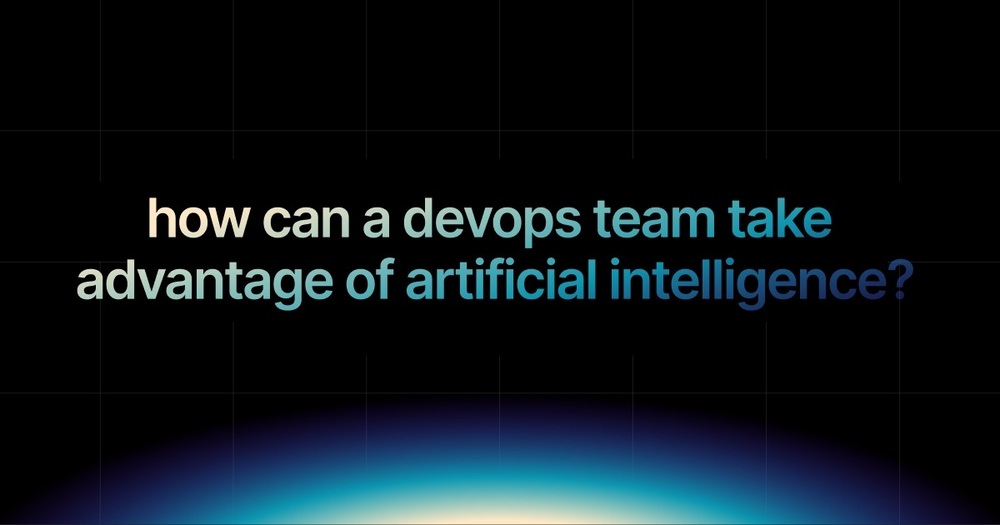
What Does It Mean for a DevOps Team to Use Artificial Intelligence?
One of the most common questions DevOps engineers ask in 2025 is: how can a DevOps team take advantage of artificial intelligence to work faster and smarter? The answer lies not in replacing human expertise, but in amplifying it.
Artificial Intelligence in DevOps means letting algorithms handle what humans shouldn’t have to. Repetitive builds, endless log analysis, and scaling decisions that depend on patterns no one can monitor manually.
When applied correctly, AI becomes a quiet but constant teammate: learning from every deployment, predicting risks before they happen, and automating the operational grind that slows teams down.
Unlike traditional automation, which follows fixed scripts, AI in DevOps adapts to live data. It studies your infrastructure, identifies recurring issues, and continuously improves system performance. This evolution from simple pipelines to intelligent pipelines allows teams to spend less time troubleshooting and more time improving software.
In simple terms, AI doesn’t replace DevOps. It empowers it. It helps engineers automate with context, analyse with accuracy, and act with confidence.
For example, an AI-powered monitoring system can flag unusual CPU behaviour hours before an outage occurs, or automatically adjust workloads to save cloud costs without human input.
The result is a faster, more reliable, and cost-efficient DevOps ecosystem where innovation moves at the speed of insight.
To understand how AI fits naturally into a developer’s workflow, explore AI in DevOps and Developer Workflow, which explains how teams can integrate intelligence into their everyday processes.
Why Should DevOps Teams Start Adopting AI Now?
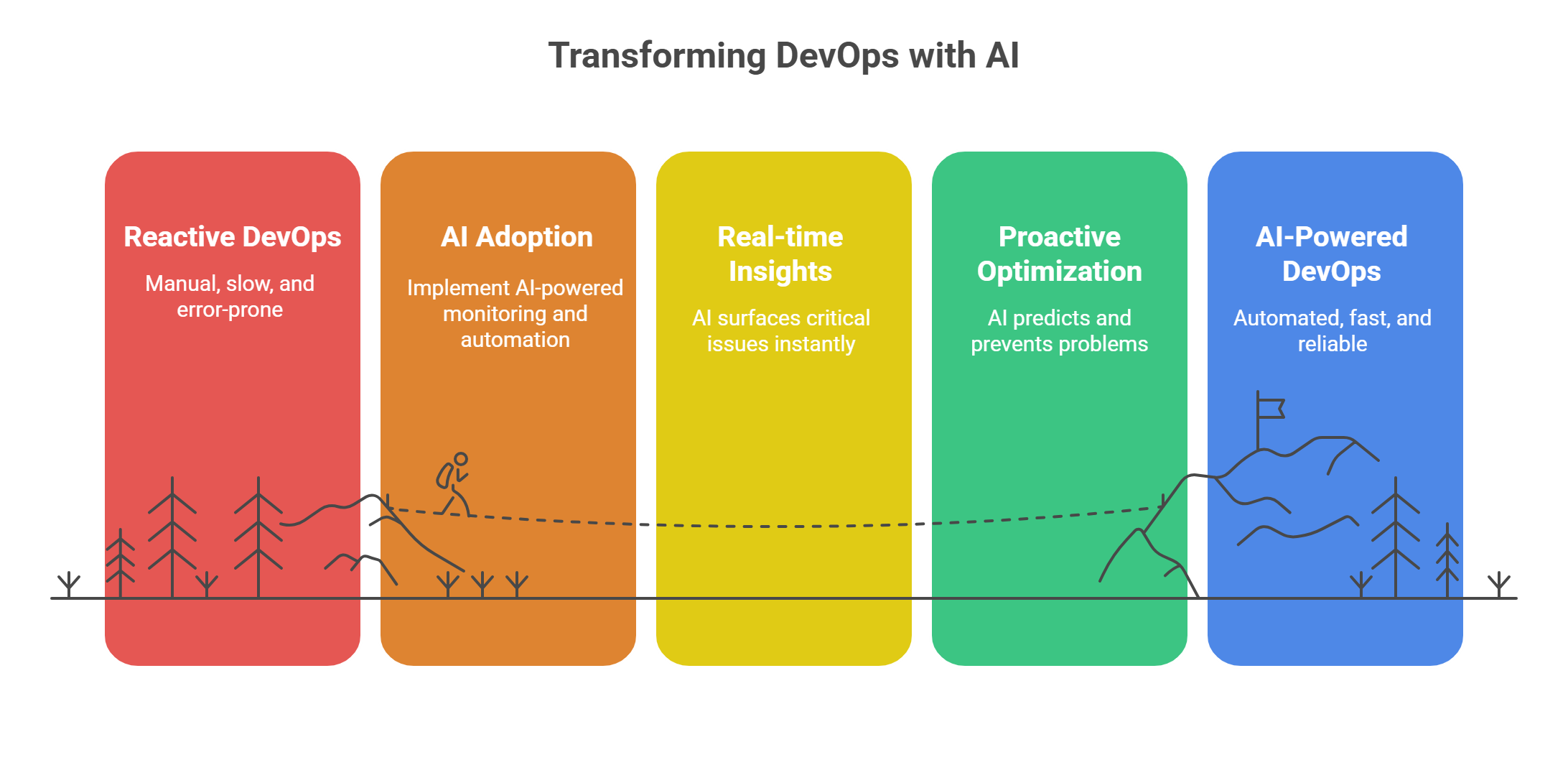 Modern software systems have reached a scale where traditional DevOps practices alone can’t keep up. Applications run across multi-cloud environments, containers spin up and down by the minute, and microservices communicate through hundreds of moving parts.
Modern software systems have reached a scale where traditional DevOps practices alone can’t keep up. Applications run across multi-cloud environments, containers spin up and down by the minute, and microservices communicate through hundreds of moving parts.
In this chaos, teams spend more time managing complexity than delivering value.
That’s where artificial intelligence steps in, not as a futuristic add-on, but as a necessary evolution for DevOps.
AI helps DevOps teams handle scale, speed, and uncertainty in ways humans simply can’t. It learns from continuous streams of metrics, logs, and deployment patterns to spot inefficiencies before they hurt performance.
Instead of manually sifting through dashboards, engineers gain instant insights that tell them what to fix and why. Documentation-heavy DevOps workflows can become easier to maintain when teams convert , turning long readme files or deployment notes into structured visual overviews that simplify onboarding and cross-team collaboration.
Here’s why adopting AI now makes sense:
- Faster Recovery and Reliability: AI systems detect anomalies in real time and trigger automatic rollbacks or fixes before users are impacted.
- Reduced Cognitive Load: Teams no longer need to track thousands of metrics; AI surfaces what truly matters.
- Better Resource Optimisation: Cloud spending becomes predictable as AI continuously right-sizes resources based on live usage.
- Shorter Release Cycles: Smarter automation reduces wait time between build, test, and deploy.
The result isn’t just efficiency. It’s a more confident DevOps culture that can operate at startup speed even in enterprise-scale environments.
As one of our earlier insights in AI for DevOps: The Secret to Faster, Smarter Software Delivery explains, the future of DevOps is about combining human intuition with machine precision.
Teams that start adopting AI today will set new benchmarks for stability, speed, and cost efficiency tomorrow: CEO, Kuberns
What Are the Key Challenges DevOps Teams Face Without AI?
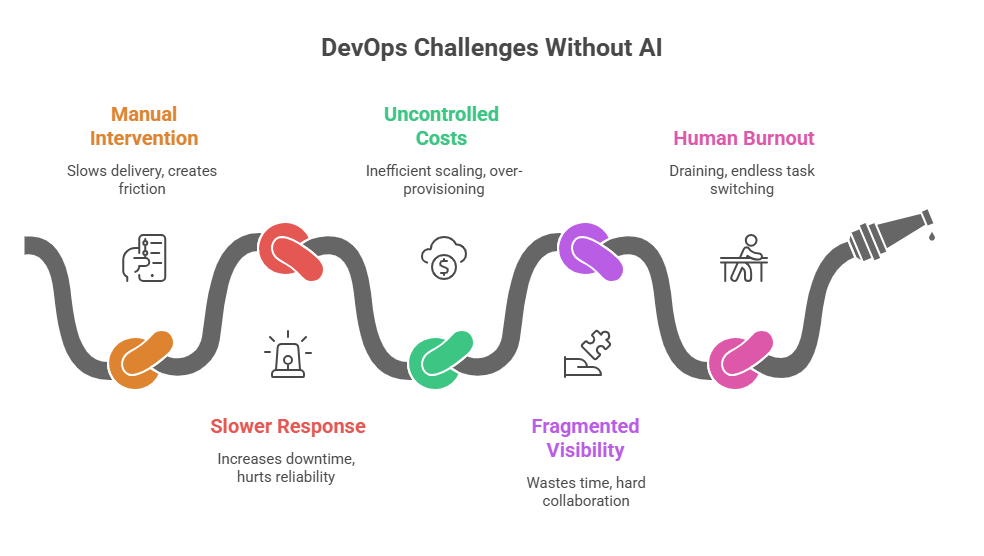 Even with great tools and talented engineers, DevOps teams often struggle to keep up with the growing scale of modern systems. As applications become more complex and workloads spread across multiple clouds, managing performance, uptime, and costs manually becomes almost impossible.
Even with great tools and talented engineers, DevOps teams often struggle to keep up with the growing scale of modern systems. As applications become more complex and workloads spread across multiple clouds, managing performance, uptime, and costs manually becomes almost impossible.
Without artificial intelligence, DevOps turns into a constant cycle of monitoring, fixing, and optimising, usually after something has already gone wrong. Here are some of the biggest challenges teams face today:
Manual intervention in pipelines
Every time a deployment fails or a test breaks, someone has to dig through logs, re-run builds, or patch scripts by hand. This slows down delivery and breaks the “continuous” part of continuous delivery. Instead of focusing on improving code or infrastructure, engineers spend hours dealing with repetitive fixes that could easily be automated. Over time, this creates friction between development and operations teams, leading to slower releases and frustrated engineers.
Slower incident response and longer downtime
Traditional monitoring systems send hundreds of alerts, most of which are noise. When an actual issue appears, it can take hours to trace the root cause. Teams manually compare logs, graphs, and error messages to figure out what went wrong. During that time, performance drops, users face delays, and service reliability takes a hit. AI can help here by identifying real anomalies, linking them to specific services, and even suggesting the most likely fix, but without AI, teams remain stuck in reactive mode.
Uncontrolled cloud costs and inefficient scaling
Most DevOps teams still rely on manual scaling rules or guesswork when managing cloud resources. Without predictive analysis, it’s easy to over-provision servers “just to be safe,” which drives up monthly bills. On the other hand, under-provisioning leads to slowdowns and downtime during peak usage. This balance is difficult to manage without intelligent automation, especially when workloads change every hour.
Fragmented visibility across multiple tools
A typical DevOps setup includes separate tools for CI/CD, monitoring, logging, and cloud management. Each has its own dashboard, metrics, and alerts. When something breaks, engineers jump between platforms trying to piece together what happened. This lack of a unified view wastes time and makes collaboration harder. AI systems, by contrast, can pull all this data together, connect the dots, and show what actually matters.
Human fatigue and burnout
DevOps is a 24/7 operation. Teams deal with overnight alerts, weekend deployments, and endless task switching. Manually tracking systems at scale is mentally draining, and constant firefighting leaves little time for learning or building new features. AI takes over repetitive and high-volume tasks, log analysis, pattern detection, and scaling, freeing humans to focus on meaningful work.
Without AI, DevOps becomes a never-ending loop of firefighting instead of continuous improvement. And as infrastructure scales, these small inefficiencies multiply into lost productivity and mounting costs.
That’s why the next step, understanding how artificial intelligence can help improve DevOps workflows, becomes so critical.
How Can Artificial Intelligence Help Improve DevOps Workflows?
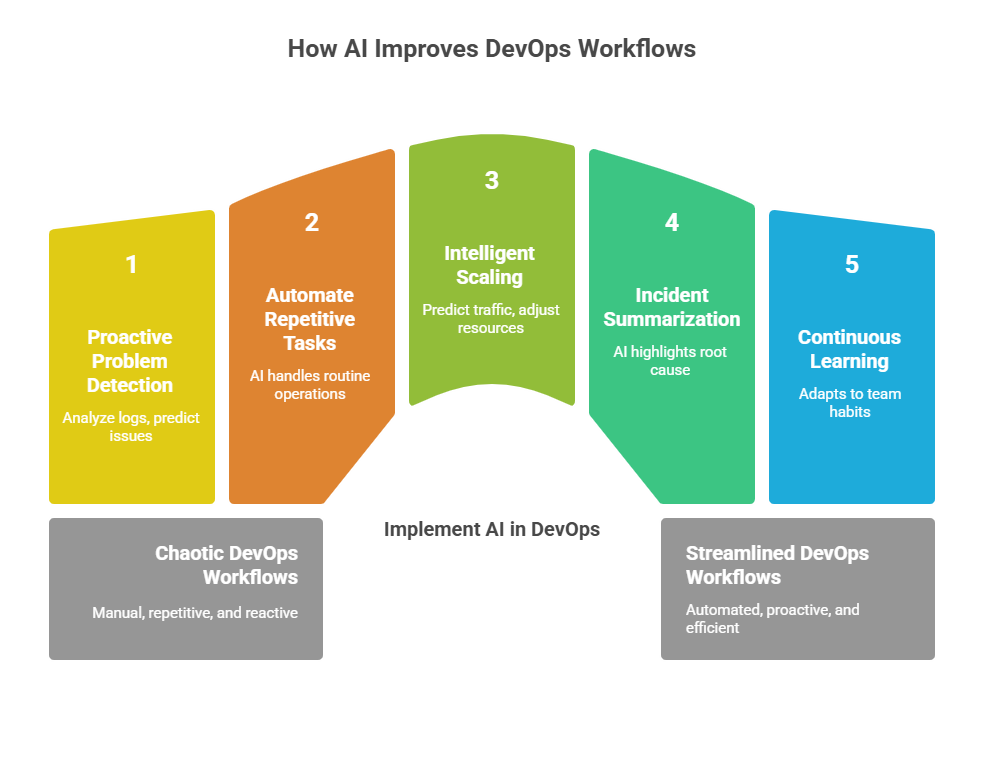 If you’ve ever worked on a DevOps team, you know how chaotic things can get. One small code change triggers dozens of builds, hundreds of logs start pouring in, and someone is always on call waiting for the next alert. Now imagine if some of those things could just… handle themselves.
If you’ve ever worked on a DevOps team, you know how chaotic things can get. One small code change triggers dozens of builds, hundreds of logs start pouring in, and someone is always on call waiting for the next alert. Now imagine if some of those things could just… handle themselves.
That’s exactly where artificial intelligence fits in.
AI doesn’t replace the team. It helps the team breathe. It learns from every deployment, every failure, and every success, then uses that data to make better decisions the next time.
Here’s what that looks like in real DevOps workflows:
Catching problems before they explode
In most setups, you only know something went wrong after it breaks. AI changes that. By analysing thousands of logs and metrics in real time, AI spots subtle signs of trouble, maybe a slow database query or an unusual CPU spike and alerts the team before users even notice. Some systems can even fix the issue automatically or roll back a bad deployment. That means fewer late-night calls and a lot more sleep for your on-call engineers.
Taking the repetitive work off your plate
DevOps teams spend hours doing the same tasks over and over: checking build results, cleaning up resources, or restarting containers. AI can take over these repetitive jobs. It learns what usually causes failures, handles quick fixes, and keeps pipelines running without waiting for manual approval. This gives engineers more time to focus on code, architecture, and optimisation, the parts that actually matter.
Making scaling smart and automatic
Scaling infrastructure manually is like guessing the weather. Sometimes you overestimate, sometimes you fall short. AI looks at usage patterns, predicts traffic surges, and automatically scales resources to match demand. When traffic slows down, it scales back to save costs. It’s like having an intelligent autopilot for your cloud environment, performance stays consistent, and budgets stay under control.
Helping teams work better together
When an incident happens, everyone scrambles to figure out what went wrong. Logs, graphs, and dashboards tell different stories. AI simplifies that chaos. It can summarise incidents in plain language, highlight the root cause, and even suggest next steps. Instead of spending hours interpreting data, teams can act immediately and learn faster from every issue.
Learning and improving with every release
AI in DevOps isn’t static. It keeps getting better. Every build, deployment, and rollback adds to its understanding of your system. Over time, it learns which changes cause problems, how traffic behaves during peak hours, and what “normal” looks like for your application. The result? A pipeline that doesn’t just run tasks but adapts to your team’s habits and goals.
If you want to see what this looks like in practice, check out How to Use AI in DevOps and Developer Workflow to Automate Deployments. It shows how real teams are already using AI to take the “ops” out of DevOps.
How Can DevOps Teams Take Practical Steps to Integrate AI?
Knowing the potential of AI is one thing. Figuring out how to actually start using it is another. Most teams don’t need a complete overhaul. They just need a practical roadmap that lets them introduce AI gradually, without breaking what’s already working.
Here’s how a DevOps team can begin integrating AI step by step:
Step 1: Start small with smarter monitoring and alerts The simplest entry point is your monitoring stack. AI-powered log analysis and anomaly detection tools can automatically group alerts, remove noise, and highlight what’s truly urgent. This means fewer distractions, faster responses, and a lot less alert fatigue.
Step 2: Bring AI into testing and deployments Once you’ve stabilised monitoring, move up the pipeline. Use AI-assisted CI/CD tools that prioritise tests, skip unnecessary runs, and validate deployments automatically. It’s a small change that often leads to fewer failed builds and smoother releases, without rewriting your workflow.
Step 3: Let AI handle scaling and resource optimisation After automating pipelines, focus on optimisation. AI can predict traffic spikes, scale infrastructure accordingly, and scale down when demand drops. No more guessing or over-provisioning, just steady performance and better cost control.
Step 4: Use AI insights for better decision-making Adopt AI-driven analytics that summarise every build, release, and post-incident review. These insights help the team identify patterns, prevent repeat issues, and make data-backed improvements rather than reactive fixes.
Step 5: Expand and refine gradually AI adoption doesn’t have to be rushed. Once you see results, expand to other areas like performance monitoring, cloud cost management, or security. The key is to integrate AI where it makes the biggest impact and keep improving over time.
All of this can be done step by step, or you can skip the setup and let Kuberns handle it all in one click. Kuberns is built to automate the entire DevOps lifecycle using AI.
From build to deployment, scaling to monitoring, it manages everything behind the scenes, while giving your team full control and visibility. You get an intelligent DevOps system that runs itself, so your engineers can focus on innovation instead of configuration.
Kuberns brings all these steps together. Try it yourself.
How Can a DevOps Team Use Kuberns to Unlock AI Benefits Instantly?
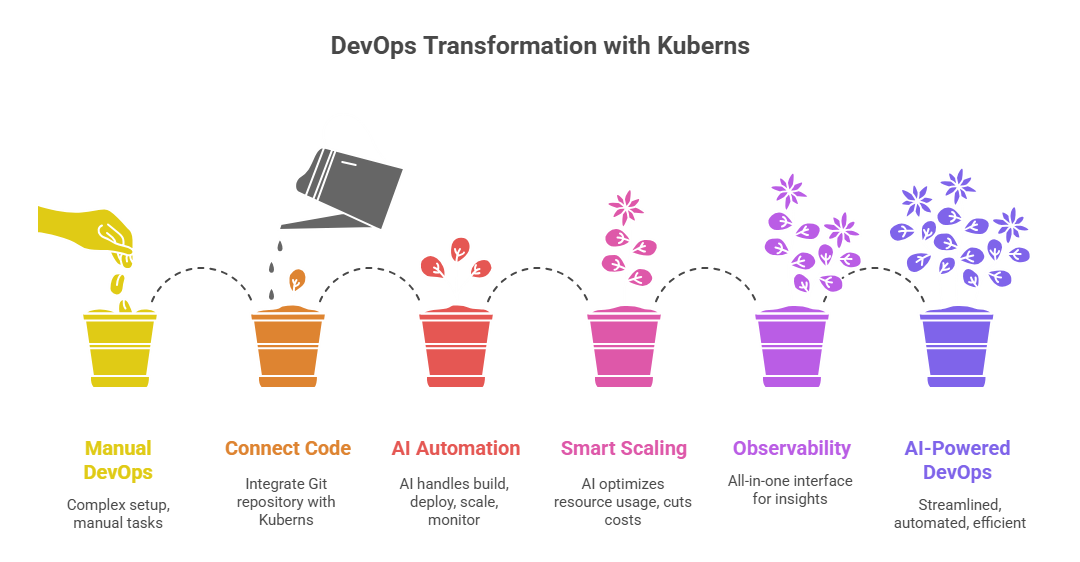 Everything we’ve covered so far, smarter monitoring, predictive scaling, and automated deployments, can transform how DevOps teams work. But building and managing all of it on your own takes serious effort. Setting up integrations, maintaining scripts, and fine-tuning infrastructure can easily turn into another full-time job.
Everything we’ve covered so far, smarter monitoring, predictive scaling, and automated deployments, can transform how DevOps teams work. But building and managing all of it on your own takes serious effort. Setting up integrations, maintaining scripts, and fine-tuning infrastructure can easily turn into another full-time job.
That’s why many teams now prefer using AI-powered platforms that already have these capabilities built in.
Kuberns brings all the advantages of AI-driven DevOps into one place, without the endless setup. It’s designed for teams that want to spend time shipping code, not managing cloud infrastructure.
Here’s how Kuberns helps DevOps teams take advantage of AI right away:
One-click deployment from code to cloud
You don’t have to piece together different tools for building, deploying, and monitoring. With Kuberns, your Git repository connects directly to the platform. AI handles the build, deployment, scaling, and monitoring automatically. That means no manual pipelines, no guesswork, and no delays.
Smart scaling that cuts cloud costs
Kuberns runs on AWS infrastructure but uses its own AI-driven engine to optimise resource usage. It automatically scales your app up or down based on demand, saving up to 40% on AWS costs while maintaining reliability and performance. Your team doesn’t have to worry about wasted capacity or unexpected billing spikes again.
All-in-one observability and automation
Instead of juggling multiple dashboards, Kuberns gives you everything in one interface, logs, metrics, health checks, and alerts, powered by AI. It tells you why something happened, not just that it did. This helps teams respond faster, collaborate better, and learn continuously.
Seamless collaboration for modern DevOps teams
Kuberns isn’t just built for automation. It’s built for teams. It gives every team member visibility into deployments, errors, and performance, creating transparency across Dev, Ops, and QA. The result is fewer blockers, fewer silos, and a shared understanding of what’s happening in real time.
Built-in intelligence, zero setup
What takes months to build manually, connecting CI/CD tools, setting up scaling rules, and configuring alerts, is already part of Kuberns by default. You just connect your code, and the AI engine handles the rest. It’s DevOps without the overhead, a system that learns, adapts, and keeps improving with every deployment.
It’s the fastest way to see everything we’ve discussed in action, from automated deployments to intelligent scaling, in a single, simple platform. If your team is ready to see what AI can do for DevOps, try deploying your next project on Kuberns and experience how easy intelligent automation can actually be.
What Does the Future Look Like for AI-Driven DevOps Teams?
AI is already changing how teams monitor, deploy, and manage infrastructure. But over the next few years, this relationship between AI and DevOps will go even deeper.
We’re moving toward AI-driven DevOps ecosystems, platforms that don’t just automate commands but understand intent. Instead of waiting for instructions, they’ll detect a slowdown, run diagnostics, and apply fixes automatically.
Here’s what that future is shaping up to look like:
AI as a teammate, not a tool:
In the next phase, AI won’t just run scripts or optimise servers. It will act as a real member of the DevOps team, analysing incidents, suggesting solutions, and learning from outcomes. Think of it as a “DevOps co-pilot” that’s available 24/7, watching every deployment and helping engineers stay ahead of issues.
Autonomous infrastructure management:
Soon, infrastructure will manage itself. AI will monitor workloads, handle provisioning, and apply patches without waiting for human input. That means fewer manual tasks, faster recovery times, and infrastructure that adapts instantly to changes in demand.
Predictive and preventive DevOps:
Rather than reacting to failures, teams will prevent them. AI will continuously analyse data patterns to predict bottlenecks or downtime before they happen. This predictive capability will move organisations from reactive operations to proactive innovation.
Smaller teams, bigger impact:
With AI handling routine operations, smaller DevOps teams will be able to manage massive infrastructures with ease. That efficiency opens new doors, faster releases, reduced costs, and more time for engineers to experiment, innovate, and improve the product experience.
How DevOps Teams Can Use AI to Focus on What Really Matters
The real question isn’t whether DevOps teams should use AI. It’s “how soon they can start”. Because at this point, the difference between teams that grow fast and teams that struggle isn’t just tools or talent, it’s intelligence.
When you bring AI into your workflow, your team stops managing complexity and starts managing outcomes. Deployments get smoother, monitoring gets smarter, and scaling feels effortless.
And while you can piece these capabilities together over time, there’s an easier way to experience them, right now.
Kuberns bring everything together from day one. It automates deployment, scaling, and monitoring using AI, so your team can work faster, reduce costs, and stay in control.
Start your next deployment with Kuberns

Frequently Asked Questions
Q1. How can artificial intelligence be applied to DevOps?
AI can automate repetitive DevOps tasks like testing, deployment, scaling, and monitoring. It learns from system data, detects issues early, and helps teams make faster, data-driven decisions that improve reliability and performance.
Q2. What are the first steps for a DevOps team to integrate AI?
Start small. Use AI-powered tools for log analysis, alert management, and performance monitoring. Once that’s stable, move into AI-assisted testing, predictive scaling, and resource optimisation to build efficiency over time.
Q3. How does AI improve CI/CD and monitoring?
AI analyses build patterns, prioritise tests, and predict potential failures before deployment. For monitoring, it detects anomalies, summarises incidents in plain language, and can trigger automated rollbacks or fixes to minimise downtime.
Q4. Can AI tools reduce cloud costs for DevOps teams?
Yes. AI continuously tracks infrastructure usage and automatically scales resources based on real-time demand. This eliminates waste and can reduce cloud spending by up to 40%, as seen with AI-powered platforms like Kuberns.
Q5. How does Kuberns use AI to automate deployment and scaling?
Kuberns connects directly to your code repository and uses AI to manage build, deployment, and scaling automatically. It runs on optimised AWS infrastructure, helping teams deploy faster, maintain uptime, and cut costs without managing multiple tools.